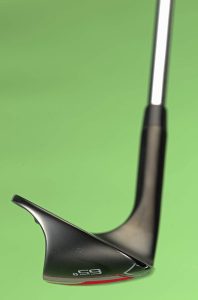Wedge Bounce
Knowledgeable golfers are aware of loft and lie angles of their clubs. But with a wedge, there is a third angle that is often overlooked. That is called the “bounce”. What is the bounce and how does it affect your shots?
The bounce angle is that between the ground and leading edge of the club as the sole is rested on the turf. It’s basically the part of the wedge that hits the ground on the swing. If proper contact is made, the spin and control of wedge shots can be ideal. If you look at several wedges, you can tell which has more bounce by how far the leading edge is above the ground.
Types of Bounce
There are several types of wedges, each with different types of bounce. The pitching wedge is generally included in the basic iron set and has the least loft of the wedges. A gap wedge is common on shorter shots where you can still make a full swing and not forced to make a partial swing with a pitching wedge. The sand wedge is typically for use out of bunkers and very thick rough. The lob wedge is the second-highest in terms of loft and are used for short shots that require quick, high loft.
Examining bounce, you’ll generally see three types. Low bounce wedges have around 4 to 6 degrees of bounce. These are ideal to use on firm lies and bunkers with very hard sand. The less bounce generally means cleaner contact, so players with a shallow descent into the ball will benefit from a bounce. Shots where low bounce is preferred are flop shots and shots near the green off a tight lie.
Wedges with bounce between 7 and 12 degrees are fit to play well on all types of surfaces with a variety of swing planes. Golfers that are looking for creativity around the greens will benefit from a medium bounce. Distance, control, and trajectory come to the forefront for the mid-bounce wedges.
Wedges with a bounce over 12 degrees are perfect for those with a steep descent into the ball and take large divots. These clubs play well in bunkers with soft sand or lies on softer turf. With the high bounce comes more spin, promoting more control.
Choosing Wedge Bounce
With other clubs in the bag, swing speed is vital to determine the proper club. However, the most important thing when picking the right bounce is the swing path and turf conditions generally played.
Golfers with a shallow attack that take small or no divots should opt for low bounce. Those that have a neutral swing path and average angle of attack into the ball are best suited for the middle bounce. Those players that take large divots are best suited for the high bounce.
When it comes to turf conditions, a low bounce wedge is best with firm conditions, both grass and sand. The middle bounce can be used with any conditions, but is deal for turf normal to firm, while high bounce is best on soft turf and sand.
If you take the time to examine your swing plane and turf conditions, you’ll have the proper wedges to help save precious shots in the short game.
